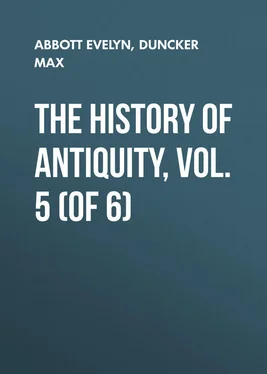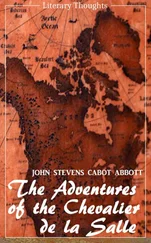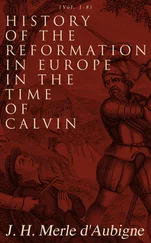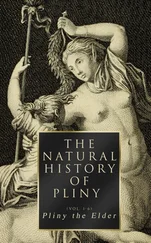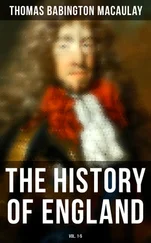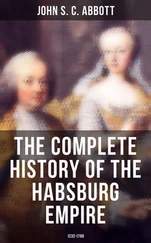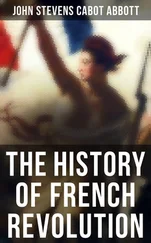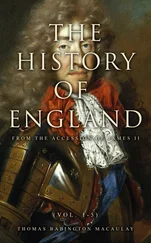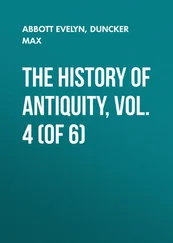Evelyn Abbott - The History of Antiquity, Vol. 5 (of 6)
Здесь есть возможность читать онлайн «Evelyn Abbott - The History of Antiquity, Vol. 5 (of 6)» — ознакомительный отрывок электронной книги совершенно бесплатно, а после прочтения отрывка купить полную версию. В некоторых случаях можно слушать аудио, скачать через торрент в формате fb2 и присутствует краткое содержание. Жанр: foreign_antique, foreign_prose, Историческая проза, на английском языке. Описание произведения, (предисловие) а так же отзывы посетителей доступны на портале библиотеки ЛибКат.
- Название:The History of Antiquity, Vol. 5 (of 6)
- Автор:
- Жанр:
- Год:неизвестен
- ISBN:нет данных
- Рейтинг книги:4 / 5. Голосов: 1
-
Избранное:Добавить в избранное
- Отзывы:
-
Ваша оценка:
- 80
- 1
- 2
- 3
- 4
- 5
The History of Antiquity, Vol. 5 (of 6): краткое содержание, описание и аннотация
Предлагаем к чтению аннотацию, описание, краткое содержание или предисловие (зависит от того, что написал сам автор книги «The History of Antiquity, Vol. 5 (of 6)»). Если вы не нашли необходимую информацию о книге — напишите в комментариях, мы постараемся отыскать её.
The History of Antiquity, Vol. 5 (of 6) — читать онлайн ознакомительный отрывок
Ниже представлен текст книги, разбитый по страницам. Система сохранения места последней прочитанной страницы, позволяет с удобством читать онлайн бесплатно книгу «The History of Antiquity, Vol. 5 (of 6)», без необходимости каждый раз заново искать на чём Вы остановились. Поставьте закладку, и сможете в любой момент перейти на страницу, на которой закончили чтение.
Интервал:
Закладка:
If the Indians have placed the old Arian legend of a golden age on earth in the days of Yima's reign, they have also, after their manner, depicted his heavenly kingdom with brighter colours, while among the Iranians this part of the legend is combined with the heavenly garden into which Yima receives the men he has selected as the best. Nevertheless, a reminiscence of Yima's garden has remained beyond the Indus in the story of the Uttara Kurus, who dwell beyond the holy mountains to the north. 69 69 Vol. IV. 21 n. Spiegel, "Avesta," 3, Einl. s. 58. The favourite comparison of the enclosure of Yima with the deluge of the Hebrews appears to me anything but apposite. Iran, and still more Bactria, is unsuited to give rise to the legend of a flood. Nor is there any question of the destruction of evil men (if there had been, Yima would have been the most guilty and the least deserving of pardon), but of the end of the golden age, as is shown in the Vendidad, the Yaçna, and the Yashts: the earth becomes more thickly peopled, men and animals do not grow old or die. If we must bring together things which have really no relation to each other, it would be more apposite to compare the paradise of the Hebrews. The reason for the end of the golden age is the guilt of Yima. [Cf. Kuenen, "Religion of Israel," 3, c. 9, E. T.]
The most striking variation from the common Arian myth in the Avesta is the statement that Yima is subordinate to a deity, Auramazda, of whom the Arians of India knew nothing. The old legend is thus brought within the sphere of new views, which must have exercised still further influence upon it. It is Auramazda who places in the hand of Yima the control, superintendence, and protection of animals and men. It is not through Yima's own desire, as was certainly the case in the old legend, but at Auramazda's bidding, that the enclosure is made, and the selected men, animals, and trees brought into it. The main reason for this change was the necessity of giving an answer to the question, Why did not the golden age continue? and if, long after Yima, Zarathrustra proclaimed a new and better law, why had not Auramazda revealed this law to the favoured Yima? In order to answer this riddle, the Avesta represents Auramazda as asking Yima to become "the preacher and bearer of his doctrine," and Yima refuses to accept this mission. Hence Yima becomes guilty of a fault, and a reason is given why the golden age, the thousand years of the reign of Yima, came to an end. Without the good doctrine, the invasion of evil spirits, and with them of heat and cold, sickness and death, strife and blight, could not be kept back from the earth. This trait of the guilt of Yima, which is entirely unknown to the earlier legend, is carried out still further. According to the prayer in the Avesta (p. 34) blessing and immortality continued in the kingdom of Yima, "till he began to love lying speech." When he had rejected Auramazda's law he cannot himself resist the seduction of evil spirits. The first offence brings on the second, and this causes the triple loss of majesty, which at length ends in the fall and violent death of Yima, an incident already indicated in the Avesta. 70 70 "Zamyad Yasht," 46.
How this form of the legend allowed the garden of Yima to be placed on the divine mountain, and whether the contradiction was removed or not, our fragments do not enable us to decide.
In the Veda it was Indra who had to contend against Vritra and Ahi, i. e. the serpents, and the black spirits, which desired to drink up the water of the sky and veil its light. In Iran, as we shall see, this office is transferred to other spirits, and also to Thraetaona. The Azhi dahaka of the Avesta is the Ahi of the Veda. Ahi and Azhi are the same word, with the same meaning; the addition dahaka refers to the destructive power of this demon. Verethraghna, i. e. the slayer of Vritra, stands in the Avesta at the side of Thraetaona in his struggle with Azhi (p. 35), and the morning wind supports him just as in the Veda the winds assist Indra against Ahi and Vritra. Among the Indians, Traitana is a spirit of the air, who dwells in the remotest regions of the sky, who hews off the head of a giant from his shoulders, and in the Veda, Trita, the son of Aptya, drinks the draught of Soma, in order to win strength for the slaying of Vritra; he slays the snake with three heads and seven tails; with his iron club he splits the hollows in the rock in which the demons have hidden the cows of the heaven (the rain clouds). 71 71 "Rigveda," 1, 158; 10, 8, 5.
In the Veda, Aptya is the father of Trita; in the Avesta, Athwya is the father of Thraetaona. Of Trita, whom it represents as sprung from Çama, the Avesta declares that he was the first physician; in the Veda we are told of Trita he knew how to heal sickness as the gods had taken his sickness from him; that he bestowed long life. 72 72 Westergaard in Weber's "Ind. Studien," 3, 413 ff., 426 ff. Kuhn combines Trita with Triton and Tritogeneia; Hofer's "Zeitschrift," 1, 276, 289.
The two figures of Trita and Traitana gradually unite in the Veda; in the Avesta, Thrita and Thraetaona remain separate persons. The Kereçaçpa of the Avesta seems to correspond to the Kriçaçva of the Indians, whom we first find in the Epos, where he is celebrated as a warlike Rishi. 73 73 Haug, "Essays," pp. 235, 236.
If the Paradhatas, Yima, Athwya, Thraetaona, Thrita, and Kereçaçpa in the original conception are spirits of the sky, if the monsters with which Thraetaona and Kereçaçpa struggle are not to be sought on earth but in the heavens, if in these dragons we find once more the cloud-serpents, against which Indra and his company have to contend – we do not at once set foot upon earth, when we come to the Kavanians. According to the later tradition of Iran, Kava Kavata was fetched from the divine mountain in order to reign over the country; two white falcons bring him a golden crown. The Rigveda mentions Kavya Uçanas, i. e. Uçanas, the son of Kavi, who brings the cows of the sky, i. e. the clouds, to the pasture. 74 74 Kuhn, "Beiträge," 4, 44; Haug, "Essays," pp. 235, 236.
In the Avesta, Kava Uça sacrifices not only to rule over the whole earth but also over the spirits. According to a later tradition this sovereign – now called Kai Kaus – causes beautiful castles to be built on the divine mountain by the demons, and is then carried by four eagles into heaven. Kava Huçrava, for whom in the Avesta the god Haoma contends, is without sickness and death (p. 37). In the later tradition, in which he is known as Kai Chosru, he begins a pilgrimage to heaven after conquering and slaying his opponent the Turanian Franghaçiana, like the sons of Pandu in the Mahabharata after their victory over the Kurus and their happy reign. Like them also, Kai Chosru climbs the mountains and disappears from his companions at a well. Against his command they seek him in the mountains, and are all buried in a great snow-storm. From the name Manuschithra (p. 37), i. e. scion of Manu, we may conclude that the twin brother of Yama, "father Manu," was not unknown to the Arians of Iran. But the genealogy in which the Avesta has preserved these names has no greater claims to historical value than the figures which have passed in review before us. Airyu is the son of Thraetaona; i. e. from the mightiest hero, the slayer of the great dragon, are sprung the sovereigns and the nation of the Airyas; the son of Airyu is Manuschithra; from whose son, Naotara, are derived the two last Kavas, Aurvataçpa and Vistaçpa.
If the coincidence of the forms from Yima to Kava Huçrava with the Veda is a proof of the antiquity and genuineness of the tradition of the Avesta, the gain for history becomes less instead of greater. No one would take mythical persons for historical. Yet the style and form in which we find these traditional statements in the fragments of the Avesta supply certain guides for the lost history of Eastern Iran. The splendour of the royal majesty is so often and so distinctly brought into prominence, that the conclusion forces itself upon us, that the regions in which the Avesta arose, i. e. the north-east of Iran, must have been acquainted with a powerful and highly-respected monarchy. The ancient spirits of the sky are changed in the Avesta into mighty warriors and far-ruling kings, a circumstance in favour of the supposition that an empire once existed here, the image of which is reflected on prehistoric times. It is in Epic poems that the spirits of the first sky become heroes, and Epic poetry only arises in and follows on periods of war and conflict. The fact that the forms of the spirits thus changed into heroes by Epic song are turned into the forefathers of the kings and progenitors of the nation, further establishes the conclusion that a military monarchy must have been in existence here; only warlike princes could appear as the heirs of heroes. Moreover, the Avesta extols the high banner of Bakhdhi and speaks of the neighbouring regions as favoured; the later tradition of Iran marks out Bactria very clearly as the abode of Aurvataçpa and Vistaçpa; in the third century B.C. Bactria supplied its princes with means not merely to achieve their own independence, but to maintain it against the great kingdom of the Seleucids and to subjugate the land of the Indus (p. 25 ff.); and if, in addition to these facts, we bear in mind the conceptions found in the Median poems of the great power of the kings of the Bactrians, their treasures in gold and silver, their fortified city, the conquest of which was the greatest achievement of Ninus – we may venture to assume that before the days of the Medes, i. e. before the year 650 B.C., there must have existed an important monarchy in the north-east of Iran.
Читать дальшеИнтервал:
Закладка:
Похожие книги на «The History of Antiquity, Vol. 5 (of 6)»
Представляем Вашему вниманию похожие книги на «The History of Antiquity, Vol. 5 (of 6)» списком для выбора. Мы отобрали схожую по названию и смыслу литературу в надежде предоставить читателям больше вариантов отыскать новые, интересные, ещё непрочитанные произведения.
Обсуждение, отзывы о книге «The History of Antiquity, Vol. 5 (of 6)» и просто собственные мнения читателей. Оставьте ваши комментарии, напишите, что Вы думаете о произведении, его смысле или главных героях. Укажите что конкретно понравилось, а что нет, и почему Вы так считаете.
